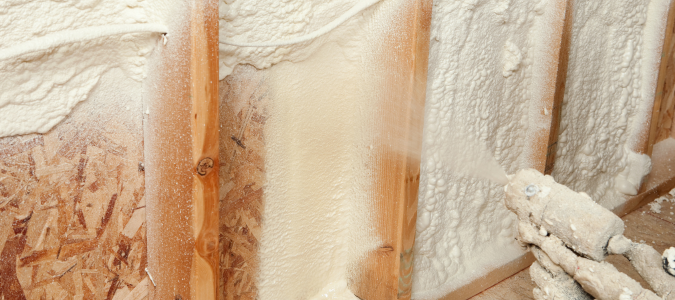Proper insulation is one of the best ways to regulate the temperature in your home and keep everyone comfortable. But with the variety of insulation materials available, it can be hard to settle on one. The usual dilemma homeowners have is choosing between spray foam insulation versus fiberglass. The former is the more traditional option, while the latter has been rising in popularity recently. Here’s an in-depth comparison of the two insulation materials to help you decide.
Fiberglass Insulation
Fiberglass is a combination of fine fibers from recycled materials and melted glass. An adhesive agent, such as aluminum foil or glass, holds these small components together. This bonding of materials creates a vapor barrier. Most American homes use fiberglass because it is an effective and affordable insulation.
Fiberglass can come in batts, which look like cotton candy blankets. They are light and portable, making them perfect for adding insulation to an attic. A less popular version is loose-fill fiberglass chunks, which professionals blow into place using a specialized machine.
Spray Foam Insulation
Spray foam insulation is sprayed onto various areas of the home by a professional. The thick foam will expand and cover all nooks and crannies, sealing off every crack that lets air through. You can’t get that level of coverage with traditional fiberglass.
There are two types of spray foam, the first one being open-cell. It is soft and highly malleable, thanks to the air bubbles inside. But because of its structure, it doesn’t provide a total seal. On the other hand, closed-cell spray foam has minimal spaces in between, so it offers a completely airtight seal.
Spray foam should not be used in houses that have regular gas appliances. Spray foam requires special gas appliances, including a gas furnace and water heater. This is because spray foam houses don’t breathe like fiberglass houses.
Spray Foam Insulation Versus Fiberglass: Pros and Cons
The best way to choose between fiberglass and spray foam insulation is by comparing their pros and cons in various performance areas. Here are some things to consider as a homeowner.
Energy Efficiency
Around 30 percent of cool or hot air can pass through fiberglass insulation—even more if the installation isn’t correct. That’s why spray foam insulation wins when it comes to energy efficiency. It can fill large and small spaces and act as a complete air barrier so none of your AC or heater’s hard work goes to waste.
R-Value
R-value refers to a product’s ability to keep heat flow in or out. The higher the R-value, the better it is at stopping hot air from escaping. The ideal R-value for home insulation is 38. Since spray foam has an R-value of 6 per inch, it must be 6.3 inches thick to achieve R-38. On the other hand, every inch of fiberglass only has an R-value of 2.2. That means you need to install a much thicker layer to reach R-38.
Moisture Resistance
Fiberglass insulation does a good job of resisting moisture. It doesn’t absorb water, so it doesn’t allow mold or mildew growth. As for spray foam insulation, it is best to opt for the close-cell type if you’re worried about water damage. The higher-density kind is entirely waterproof. However, it is not the same for open-cell spray foam. Because it is light and expands, it doesn’t offer much resistance against moisture.
Durability
Both fiberglass and spray foam home insulation have a long life span. However, spray foam tends to shrink over time, giving fiberglass a slight upper hand in this department.
Installation
There’s no beating fiberglass when it comes to ease of installation. It is as simple as unrolling the batts and placing them in your desired areas. The process is even easier if there are no obstacles to avoid. Even if you need a professional with a machine to set up loose-fill fiberglass, it is still not as complicated as spray foam installation.
Never install spray foam insulation on your own. Leave the job to a licensed professional who can do it safely.
Cost
Spray foam insulation can be double or triple the price of fiberglass because of its complex installation process. But even though you have to spend more upfront, you can save more down the line because spray foam is more energy-efficient. Your lower monthly utility bills may offset the initial cost.
Rockwool Insulation Versus Fiberglass: Pros and Cons
Another insulation material homeowners can consider is rockwool, otherwise known as mineral wool. Here’s how it fares against fiberglass.
R-Value
While rockwool and fiberglass can both prevent air leakages, the former has a slight advantage. Given the standard thickness of 3.5 inches, a rockwool batt has an R-value of 15, while fiberglass has 13. That means rockwool is around 15 percent better at insulation and is more energy-efficient.
Moisture Resistance
Rockwool and fiberglass both have a high moisture resistance level and aren’t prone to water damage. You can protect them further with faced insulation, which comes with a paper or foil layer to act as a vapor barrier. Also, you can get higher-density rockwool to increase its water resistance. That’s because there are fewer air pockets inside to absorb moisture.
Installation
Fiberglass is the clear winner when it comes to installation. It is light and pliable, so it is easy to place in crawl spaces and other challenging areas. You can cut it into various shapes and sizes to make it fit. On the other hand, rockwool is heavy, dense and rigid, making it harder to work with. You should only choose rockwool if you are covering large areas with regular shapes.
Cost
While prices depend on your supplier, you can expect to pay more for rockwool than fiberglass. One square foot of rockwool is around 75 cents, while fiberglass of the same size is typically only 60 cents. That’s a 25 percent difference per square foot, which can add up if you have a large area to cover.
If you still can’t decide if rockwool or fiberglass is better for your home, you can get an HVAC professional‘s opinion. They will assess your space, consider your budget and give you their recommendation. Then, they can install the insulation for you.
How To Install Insulation in a Crawl Space
Having a crawl space can be beneficial in many ways. They provide easy access to the electrical and plumbing systems and allow for better ventilation inside the home. But they can also be a source of expensive problems. They are usually damp, making them the perfect breeding ground for pests and mold. If you have a crawl space at home, it is essential to insulate it to prevent these issues. Doing so will save you money and energy in the long run.
However, insulating a crawl space isn’t an easy task. Incorrect insulation can encourage the growth of mold and mildew even more. It is a labor-intensive job that you should leave in the hands of a professional. Here’s how the pros install insulation in crawl spaces.
Preparation
Crawl spaces are damp and dirty. Some steps must be taken before starting the installation process. The following preparations will ensure that the insulation will work properly:
- Clear all items and debris from under the house.
- Even out the ground in the crawl space.
- Resolve any standing water issues under the house.
Insulation for Unventilated Crawl Space
When working with an unventilated crawl space, HVAC professionals focus on the walls instead of the subfloor. That eliminates the need to insulate the pipes and ducts separately, lessening the required materials. They will likely use faced insulation to prevent moisture from transferring from one place to another. Unventilated spaces heat and cool with the rest of the house, so a vapor barrier is essential. In addition, they will usually install rigid insulation material for crawl space walls to make it a more permanent solution.
Insulation for Ventilated Crawl Space
A ventilated crawl space is better suited for insulation because it helps eliminate moisture and prevent structural damage. In this scenario, professionals will focus on the underside of the subfloor and use unfaced insulation. The usual choice is fiberglass because it is easy to place between floor joists.
Insulating your home and crawl space is a lot of work and money, but it is worth it in the long run. While you can go the DIY route, it is better to turn to professionals to complete the installation process seamlessly and safely. They can also help with other questions about your home’s HVAC system, like when to replace your air conditioner and how to properly maintain it.
ABC Can Help You Save on Your Electric Bill
Everyone wants to save money on their heating and cooling costs and make their homes more energy-efficient. Installing insulation in your home can be time-consuming if you are not an expert. If you want to make your home more energy-efficient, contact ABC Home & Commercial Services. Our HVAC experts can remove your old insulation and install new insulation for you.



